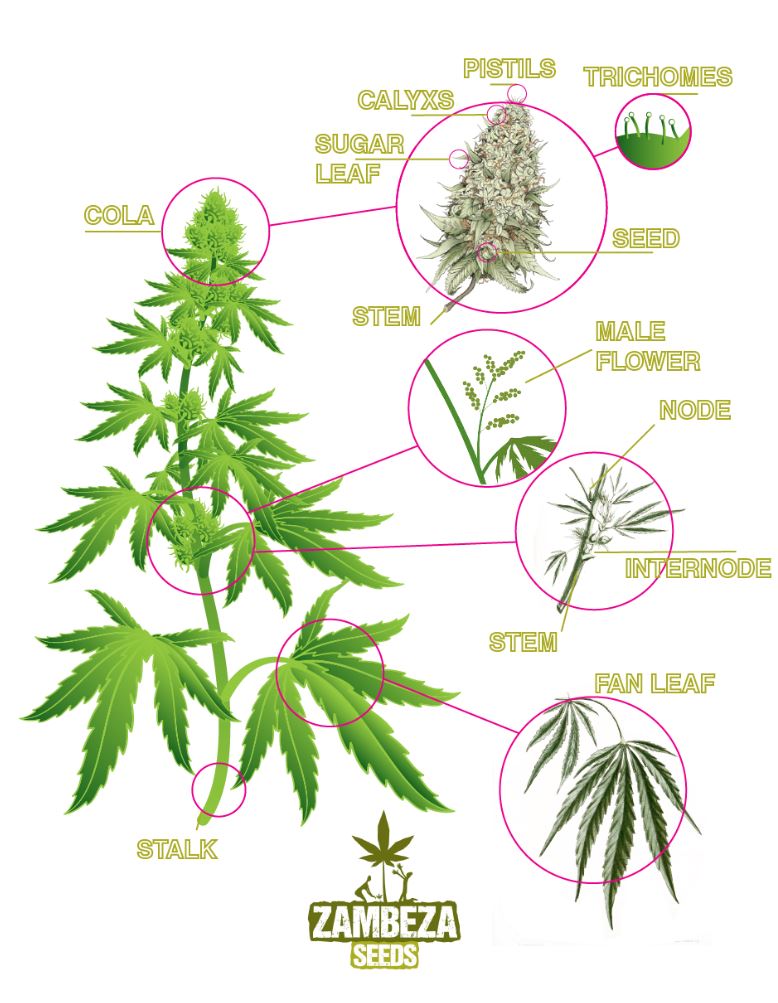The Anatomy Of A Cannabis Plant
Published :
Jan 20, 2017
Categories :
Other subjects

Cannabis plants are pure magic, they are composed of many parts. Let's investigate the anatomical composure of cannabis to acquire some dank knowledge.
Have you ever pondered over these small intricate components of the bud? It looks like a bundle of magic, we know, but if you want to step-up your knowledge of the cannabis anatomy and impress your fellow ganja consumers, then stay with us.
We will mainly discuss the female plants and the anatomy of the buds.
MALE & FEMALE
The buds you stashed in your jar derive from the female plant (hopefully). The cannabis plants are either female, male or hermaphrodite. The anatomy of the plant will depend on the sex of the plant. The male plants carry pollen sacks which function as a reproductive system, when the females are pollinated they begin generating seeds. The hermaphrodite plants are half-male half-female, these plants can pollinate themselves and create seeds, although this is undesirable for cannabis consumers due to the low potency, and spoiling of the pure female gene. The dank buds that we consume come from seedless “sinsemilla” females. Growers can ensure the femaleness of the plant by purchasing or creating feminized seeds or cloning the mother plant.
COLA
The sites where buds grow are also known as colas, it’s also referred to as “bud sites”. The plant will have a main cola (also called an apical bud) which forms at the top of the plant, it’s usually the plant's biggest bud. Smaller colas grow from the nodes of the plant, between the fan leaves. These colas are usually much smaller, but they can be enlarged by using techniques such as LST (Low-Stress-Training), and screen of green (ScrOG). The colas can also mature at different times, in many cases, the main cola will mature before the smaller colas, due to different light exposures.
CALYX
The anatomical flowers of the cannabis plants are called calyxes, they look like tear-shaped nodules. So, go to your jar, pick out a bud and notice in between the small leaves called “sugar leaves”, you can encounter the small calyxes which are rich in trichomes, THC, cannabinoids and other lavish substances.
PISTIL
Have you ever wondered what these tiny orange/brown hairs are doing on your bud? They are called pistils, their function is to pick up pollen and begin the seed creating process. The pistils grow out of calyxes. When the pistils start appearing from the calyxes, they are white and straight, during the maturation process they start bending and turning yellow then orange and brown, in that chronological order.
TRICHOMES
Last but not least trichomes are the crystal like hairs that contain terpenes, THC, and cannabinoids. If your bud is out, take a peek, can you see that white crystally sprinkle on your bud? Yepp that's the trichomes. The trichomes differ in their maturation process, they begin to be small and clear, then they grow in height, afterward, they turn cloudy then amber. The effects of cannabis will greatly depend on the trichomes maturation stage.
There are probably hundreds of names for different parts, substances and cells of the cannabis organism that experts study to improve the genetics of the plant. Although the aforementioned anatomical parts are a need-to-know, in order to navigate through your dank buds successfully.







































